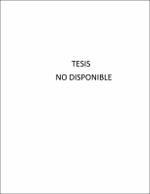Mostrar el registro sencillo del ítem
Características de los recién nacidos de madres adolescentes en el Hospital II–2 de Sullana de Enero a Diciembre del 2014
| dc.contributor.advisor | Gamarra Vilela, Jhon Omar Martín | |
| dc.contributor.author | Leiva Parra, Elias José | |
| dc.creator | Leiva Parra, Elias José | |
| dc.date.accessioned | 2018-02-21T23:54:12Z | |
| dc.date.available | 2018-02-21T23:54:12Z | |
| dc.date.issued | 2015 | |
| dc.identifier.uri | https://hdl.handle.net/20.500.12759/3715 | |
| dc.description.abstract | Determinar las características de los recién nacidos de madres adolescentes en el Hospital II - 2 de Sullana durante el 2014. Materiales y métodos: Es un estudio descriptivo observacional, retrospectivo, transversal y se revisaron las Historias Clínicas de los recién nacidos de las madres adolescentes que nacieron en el año 2014. Resultados: Hubo un total de 644 recién nacidos de madres adolescentes; del total de las madres adolescentes el 89,5% (577) si tuvieron control prenatal. Según el tipo de presentación en el 97,20% (626) el tipo de presentación fue cefálico. En el 61,44% (384) de los recién nacidos de madres adolescentes tardía el tipo de parto fue abdominal. Con respecto adolescentes el líquido amniótico de los recién nacidos de madres adolescentes fue normal en el 85,55%(551) el líquido amniótico fue normal y en el 14,44% (93) el líquido amniótico fue meconial. Según el sexo fueron en su mayoría de sexo masculino en el 51,70%(333) y en el 48,29%(311) fueron de sexo femenino, predominando en adolescentes tardías; fueron pretérmino en el 6,83%(44); el 92,54%(596) fueron a término y en el 0,31%(2) fueron postérmino. Según la Edad Gestacional en el 86,56%(541) de los recién nacidos de madres adolescentes tardía fueron AEG y en el 10,52%(2) de los recién nacidos de madres adolescentes temprana fueron PEG. En el 96,89% (624) presentaron APGAR 1´ entre 7-10. Según APGAR a los 5´ del total de recién nacidos en el 99,22% presentaron APGAR a los 5´entre 7-10. Del total fueron hospitalizados el 8,38 % (54) en NEOPATO INTERMEDIOS y en el 0,77% (5) en UCIN. No hubo fallecidos. Conclusiones: En este estudio con respecto a la morbilidad hubo mayor porcentaje HIPERBILIRRUBINEMIA en el 31,11%, SEPSIS en 15,55%, TAQUIPNEA TRANSTORA DEL RECIEN NACIDO 13,33%,EN EL 11,11% HIPOGLICEMIA, APNEA 8,88%Y POR ULTIMO 6,66% MALFORMACIONES. | es_PE |
| dc.description.abstract | evaluate the characteristics of new born of teenage mothers at Apoyo Hospital II-2 Sullana January – December 2014. Methodology: design, retrospective, The data obtained of the data processing System were revised clinical histories of newborn of teenage mother in this hospital from January to December 2014 and it treated to obtain characteristics of new born of younger teenage mothers(10-14 years old) and older teenage mothers at Apoyo Hospital II-2 Sullana from January to December 2014. It used the SPSS software obtain percentage cumulative. Results: There were a total of 644 infants of adolescent mothers; Of all teenage mothers 89.5% (577) if they had prenatal control, 10.40% (67) adolescent mothers had no prenatal care. Depending on the type of presentation at 97.20% (626) type of presentation was cephalic and 2.79% (18) type of presentation was breech. 52.63% (10) of newborns early teenage mothers the type of normal vaginal delivery. In the 61.44% (384) of newborns late teenage mothers mode of delivery was abdominal. With regard adolescents amniotic fluid of infants of teenage mothers was average at 85.55% (551) amniotic fluid was normal and in 14.44% (93) amniotic fluid was meconium. By sex were mostly male in 51.70% (333) and 48.29% (311) were female, predominantly in late teens; preterm were 6.83% (44); the 92.54% (596) were term and 0.31% (2) were post-term. According to Gestational Age at 86.56% (541) of newborns late teenage mothers were AEG and the 10.52% (2) of newborns early teenage mothers were PEG. Regarding the APGAR 1'del total of newborns of adolescent mothers in 0.77% (5) had APGAR 1'0-3 with severe depression, at 2.32% (15) had APGAR 1'entre 4 -6 with moderate depression and 96.89% (624) had APGAR 1'7-10. According to the 5'AP 0% (0) There were no deaths. Conclusions: In this study morbidity were higer percentage HYPERBILRRUBINEMIA in 31,11%, 15,55% SEPSIS, TACHYPNEA TRAN NEWBORN 13,33%, 11,11 % HYPOGLICEMIA, APNEA AND DEFFECTS IN 8,8%; FINALLY 6,66%. | en_US |
| dc.description.uri | Tesis | es_PE |
| dc.format | application/pdf | es_PE |
| dc.language.iso | spa | es_PE |
| dc.publisher | Universidad Privada Antenor Orrego | es_PE |
| dc.relation.ispartofseries | T_MEDP_028 | |
| dc.rights | info:eu-repo/semantics/closedAccess | es_PE |
| dc.rights.uri | https://creativecommons.org/licenses/by/4.0/ | es_PE |
| dc.source | Universidad Privada Antenor Orrego | es_PE |
| dc.source | Repositorio Institucional - UPAO | es_PE |
| dc.subject | Recién nacidos | es_PE |
| dc.subject | Madres adolescentes | es_PE |
| dc.title | Características de los recién nacidos de madres adolescentes en el Hospital II–2 de Sullana de Enero a Diciembre del 2014 | es_PE |
| dc.type | info:eu-repo/semantics/bachelorThesis | es_PE |
| thesis.degree.level | Título Profesional | es_PE |
| thesis.degree.grantor | Universidad Privada Antenor Orrego. Facultad de Medicina Humana | es_PE |
| thesis.degree.name | Médico Cirujano | es_PE |
| thesis.degree.discipline | Medicina Humana | es_PE |
| dc.subject.ocde | https://purl.org/pe-repo/ocde/ford#3.02.27 | es_PE |
| renati.type | https://purl.org/pe-repo/renati/type#tesis | es_PE |
| renati.level | https://purl.org/pe-repo/renati/level#tituloProfesional | es_PE |
| renati.discipline | 912016 | es_PE |
| dc.publisher.country | PE | es_PE |
Ficheros en el ítem
Este ítem aparece en la(s) siguiente(s) colección(es)
-
Medicina Humana [2969]


